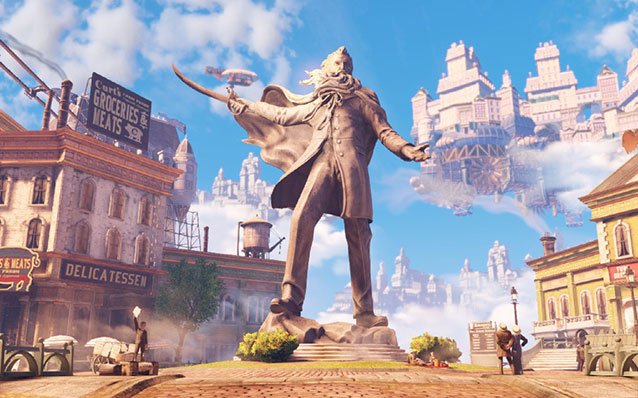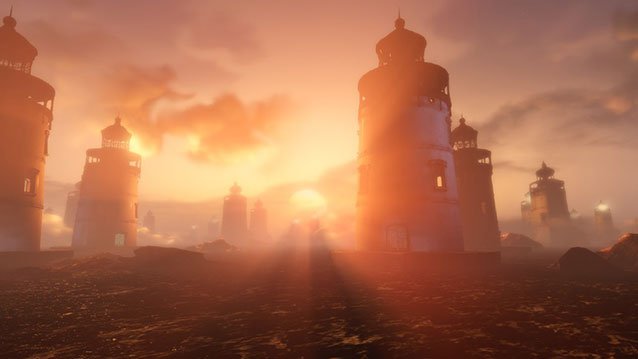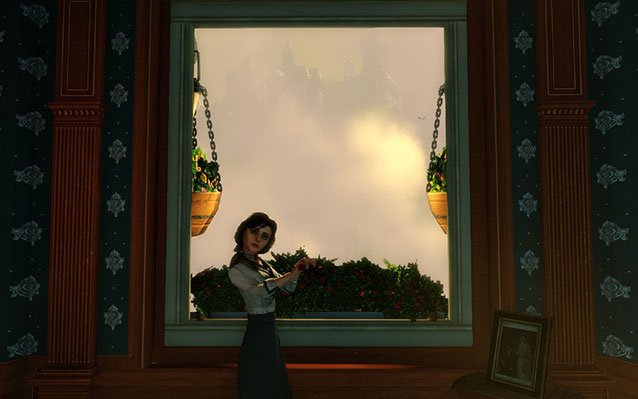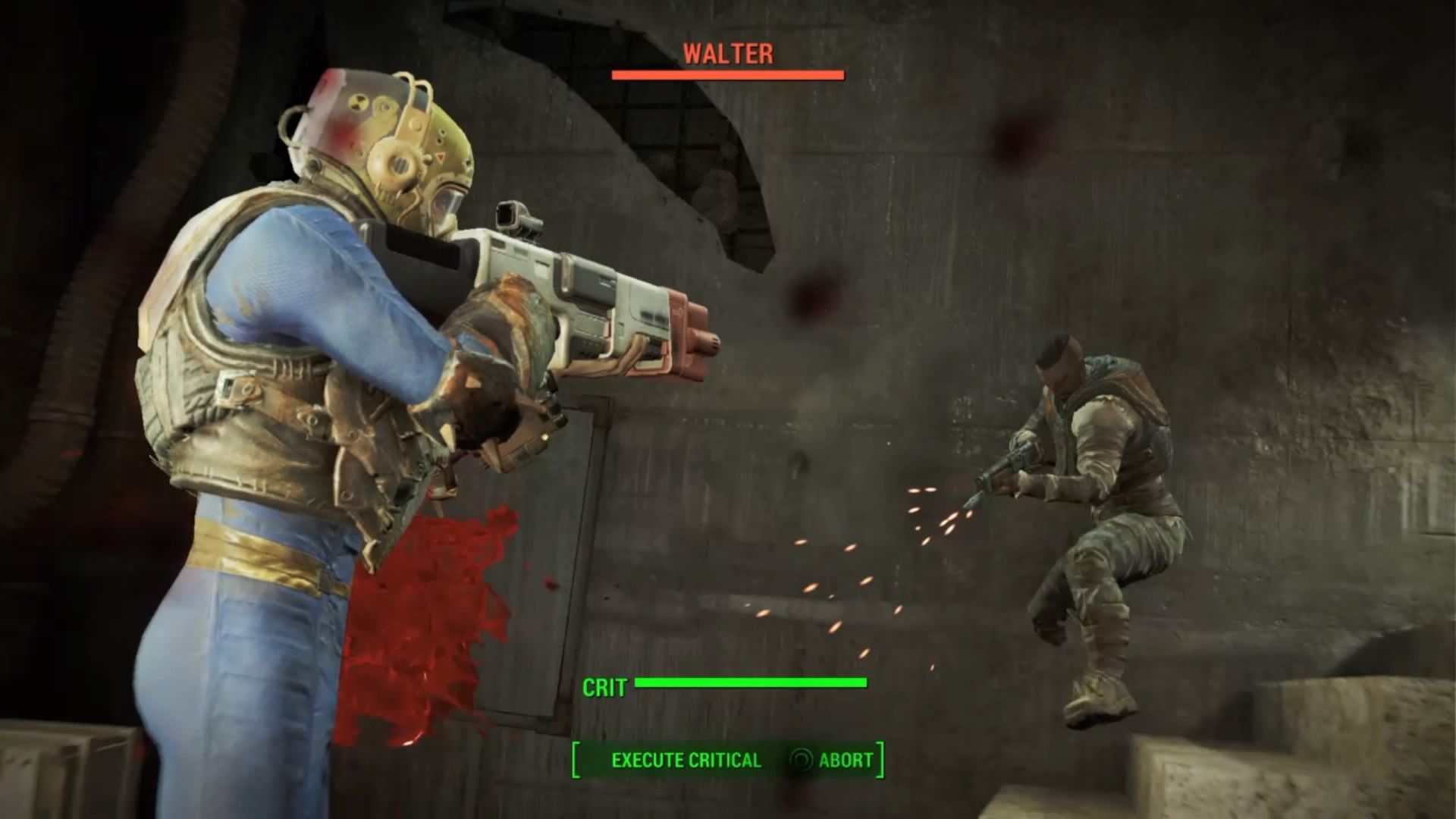


Warning: this article contains spoilers for both Bioshock Infinite and the original Bioshock.
There’s a lot that can be said about Bioshock Infinite. It could easily be described as a game about the multiverse theorem, American Exceptionalism, Fatalism, Racism, Religion, the possibility of redemption—though the game’s title is meant to invoke the notion of infinite worlds, it could just as easily apply to the game’s rich theoretical possibilities.
It also indicates the number of times that players have played this exact same game.
For any other title, this would be a cardinal sin. In the case of Infinite, it’s art. The game is filled with metanarrative features that comment on the mirage of player “choice” and the relationship between gamers and the game. All of this is gift-wrapped in fancy, gleaming visuals that inspire awe even as they provoke a sense of familiarity.
The metanarrative is at its finest in the game’s mind-bending conclusion. Elizabeth opens a “door,” directing players through a maze of walkways which lead to countless other lighthouses. By this point, she’s metamorphosed from a helpful game AI to an omniscient entity—an NPC that has become, somehow, self-aware. “There’s always a lighthouse,” she says. “There’s always a man, there’s always a city.” Her words fit the context of the game—with quantum mechanical multiverses at work, there are literally thousands of other Bookers—but they also invoke the tropes at the core of almost every video game. There’s always a man. There’s always a rich setting for him to explore. And there’s always a figurative lighthouse which allows players access to the world of the game.

The mirage of player choice is also at its most potent during this sequence. Booker frequently encounters forks in the path as he navigates from lighthouse to lighthouse with Elizabeth, and regardless of where he goes, they still end up in the same place: the end of the game. The other choices in Infinite are no different. Regardless of whether players choose the bird or the cage, to kill the cashier or pressure him, to throw the ball at the interracial couple or the announcer, or to kill or abandon Slate, the end result is always the same. They wind up at the same lighthouse, the same cutscene, and the same credits.
As though to drive this truth home, Booker and Elizabeth encounter countless other Bookers and Elizabeths in the Lighthouse sequence. The couple closest to the player appears to have made the opposite choices. If the player’s Booker has a bandaged hand, the one opposite them does not. Though it’s too far away to tell, it’s safe to assume that one of the other Elizabeths wears the cage brooch if the player opted to choose the bird. With this, the game glibly points to the possibility of replays. It stresses the opposite choices because the developers assume that most players would make those choices on their second playthrough, just to see if anything would change. In answer, the game shows their future selves on the same path with the same lighthouses even before players have the opportunity to play the game a second time.
The most important choice in the game, then, is the “choice” where players have no option. During one of Booker’s early encounters with the Lutece “twins,” they ask him “heads or tails” and have him flip a coin. The player must flip the coin to proceed, and Booker calls “heads” without player input. Rosalind tallies the result on Robert’s board, and when Robert turns around, there appears to be at least one hundred other similar tallies on the board—all heads, all called by previous Bookers. Though the tallies work within the context of the story itself, these tallies also represent other players encountering the same “choice.” They indicate how many other players have come before. By extension, the tallies also reflect on how many players are there now, and the blank space on the front of the board suggests that many more players will come. Despite appearances, players are actually faced with a choice in this moment: they may either press a button to flip the coin or stop playing altogether. Even as the game draws attention to the futility of player choices in game, it emphasizes the one, true option that players do have. The tallies represent the number of players who decided to continue playing as much as they represent the number of players who have come before.

This variety of choices with their limited impact seems retrospective. They bring to mind the core choice of the original Bioshock, in which players had to choose whether they wanted to save or harvest the Little Sisters. The original game offered a variety of endings, the positivity of which was heavily affected by the moralistic aspect of player’s choices. Infinite, with its choices all leading to the same lighthouse, has its eye leveled on the hard truth of such endings. Even if a game challenges players with hard decisions, developers can only offer a limited amount of conclusions, making the impact of the player’s moralistic choices negligible. No matter which path players take, they all end up at the same place: the ending of the game.
Most important, perhaps, is the degree to which Infinite is identical the original Bioshock. Booker manages to operate the bathysphere upon his and Elizabeth’s arrival in Rapture, and this means that he, like Jack, is genetically close enough to Andrew Ryan to operate it. Though the original Bioshock implies that this genetic proximity can include cousins, sisters, and Andrew Ryan’s family at large, it’s not a large leap of logic to assume that Booker is Jack. With this in mind, Elizabeth is a culmination of the Little Sisters, and the Songbird is also the equivalent of the Big Daddies. Even the plot twist at both games’ climax is the same: the protagonist discovers that they are also the primary antagonist. Infinite is not a new game; it is familiar content with a new face and more finesse than its predecessor.
If player choices are meaningless and the games, at their core, are identical, then Infinite argues that the true value of the medium does not lie in player choices or in the novelty of the game itself. Instead, by drawing attention to the futility of choice and the number of players engaging in the same decision, it glorifies the value of player experience. The choices—as meaningless as they are to the game’s conclusion—ensure that the experience differs from game to game. There are nearly an infinite number of ways for gamers to approach combat, thanks to the variety of weapons and combinations of vigors. In the case of Infinite, it’s the experience that matters.
It is in this representation of player experience that Infinite points to another wonderful aspect of videogames. As she guides Booker through Rapture, Elizabeth remarks that the doors lead “to everywhere,” and she suggests how “all that’s left is the choosing.” This aspect of “choice” does not reflect in-game decisions so much as it invokes the player’s option to select games for themselves. When viewed this way, Bioshock Infinite reveals itself—and all games, really—for what they truly are: doors into worlds that are infinite in their possibilities and experiences. All that’s left is the choosing, and Bioshock Infinite serves as a wise choice and a worthy addition to the video game canon.




 Fallout 4: Stop the Raiding walkthrough
Fallout 4: Stop the Raiding walkthrough Hyper Light Drifter Wiki – Everything you need to know about the game .
Hyper Light Drifter Wiki – Everything you need to know about the game . Addressing Tomb Raider and the Problematic Marketing of Lara Croft
Addressing Tomb Raider and the Problematic Marketing of Lara Croft The Sims 4 Supports Mods. How To Add Them To Your Game
The Sims 4 Supports Mods. How To Add Them To Your Game Screensavers Aren't Dead: 5 Beautiful Examples for Your Mac
Screensavers Aren't Dead: 5 Beautiful Examples for Your Mac